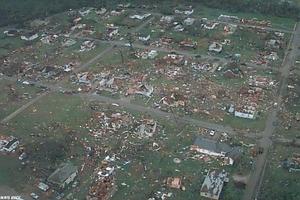Disaster recoveryGovernment moves quickly to help storm victims in South
So far residents have been fairly pleased with the government’s response to the worst natural disaster to hit the United States since Hurricane Katrina; after tornadoes touched down in seven states on Wednesday, Secretary Napolitano and other top federal officials immediately began contacting governors in the affected states; just hours after the storms had ravaged Alabama, Obama signed the declaration of disaster in Alabama and by Thursday he had done the same for Georgia and Mississippi; by Friday afternoon FEMA liaison officers had been deployed to Alabama, Georgia, Kentucky, Mississippi, and Tennessee; the storms have killed at least 350 people, injured more than 2,200, and left tens of thousands homeless in seven states

An all-too-common scene across the U.S. south // Source: findtarget.com
Following the devastating storms and tornadoes that battered much of the south, DHS Secretary Napolitano toured some of the hardest hit areas in Alabama and Mississippi on Sunday.
After touring the wreckage, Napolitano appeared stunned, saying, “I don’t think words can fairly express the level of devastation. I’m not articulate enough.”
Secretary Napolitano and Federal Emergency Management Agency (FEMA) Director Craig Fugate met with Governor Haley Barbour in Smithville, Mississippi, a town that has been effectively wiped clean by a F5 tornado that essentially knocked over every structure.
There Homeland Security chief met with local residents and pledged her support.
“This is not going to be a quick comeback or an immediate (recovery) but it will be, in my view, a complete one,” she said.
So far residents have been fairly pleased with the government’s response to the worst natural disaster to hit the United States since Hurricane Katrina.
William Bell, the mayor of Birmingham, Alabama, thanked Napolitano publicly for the government’s quick response. According to Bell, within thirty minutes of the storm hitting he had received a call from federal officials.
“We want to thank them for being ‘Johnny on the spot’ from the beginning,” Mayor Bell said.
The New York Times reports that interviews with many local residents has revealed that while some are mildly frustrated about the damage and the pace of the cleanup effort, most believe that the government and charities are responding to the disaster as best they can.
Darius Rutley, a resident of Alberta, Alabama whose house was destroyed, said, “It ain’t like Katrina. We’re getting help.”
After being criticized for waiting twelve days to tour the Gulf Coast after the Deep Horizon oil spill, President Obama swiftly flew to Tuscaloosa, Alabama, roughly forty hours after tornadoes killed 250 people in Alabama alone.
“I don’t think there’s much to mumble and grumble about,” said Axavier Wilson, who managed to survive the storm in closet after his house had blown away.
Wilson said that he was impressed that President Obama visited so quickly.
“Everybody feels secure about getting help,” he added.
After the tornadoes touched down on Wednesday, Secretary Napolitano and other top federal officials immediately began contacting governors in the affected states.
According to Art Faulkner, Alabama’s emergency management director, before the state had even submitted a formal request for federal assistance, FEMA officials were in touch with the White House about the need to issue a federal emergency declaration.
President Obama spoke with Alabama governor Robert Bentley on Wednesday night before calling four other governors in states struck by the massive storm on Thursday.
FEMA Chief Craig Fugate was immediately dispatched to Alabama on Thursday, and five senior cabinet officials joined him on Sunday.
President Obama said, “We can’t control when or where a terrible storm may strike, but we can control how we respond to it.”
Just hours after the storms had ravaged Alabama, Obama signed the declaration of disaster in Alabama and by Thursday he had done the same for Georgia and Mississippi.
By issuing a declaration, the federal government agrees to pay 75 percent of the costs to repair uninsured public buildings. Residents are also eligible for recovery grants and businesses can apply for low-interest loans.
According to a FEMA spokesman, by Friday afternoon FEMA liaison officers had been deployed to Alabama, Georgia, Kentucky, Mississippi, and Tennessee.
On 27 April, tornadoes touched down in seven states killed at least 350 people, injured more than 2,200, and left tens of thousands homeless. Alabama was hit the hardest.
